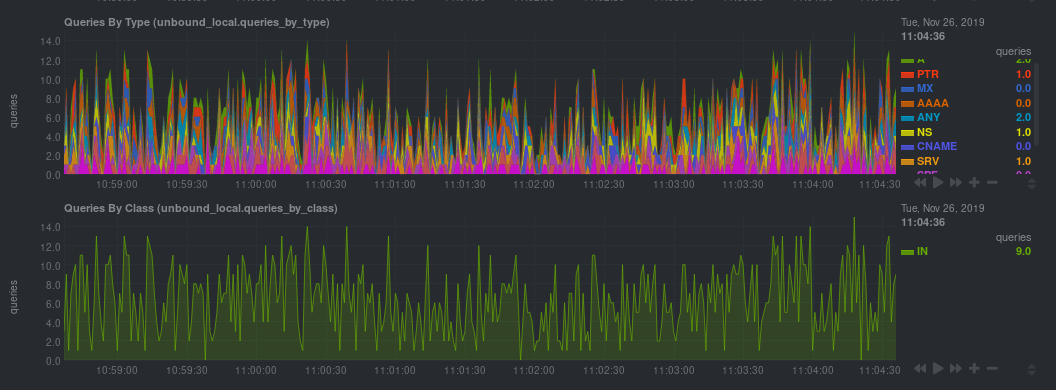Monitor Unbound DNS servers with Netdata
Unbound is a "validating, recursive, caching DNS resolver" from NLNet Labs. In v1.19 of Netdata, we release a completely refactored collector for collecting real-time metrics from Unbound servers and displaying them in Netdata dashboards.
Unbound runs on FreeBSD, OpenBSD, NetBSD, macOS, Linux, and Windows, and supports DNS-over-TLS, which ensures that DNS queries and answers are all encrypted with TLS. In theory, that should reduce the risk of eavesdropping or man-in-the-middle attacks when communicating to DNS servers.
This guide will show you how to collect dozens of essential metrics from your Unbound servers with minimal configuration.
Set up your Unbound installation
As with all data sources, Netdata can auto-detect Unbound servers if you installed them using the standard installation procedure.
Regardless of whether you're connecting to a local or remote Unbound server, you need to be able to access the server's
remote-control interface via an IP address, FQDN, or Unix socket.
To set up the remote-control interface, you can use unbound-control. First, run unbound-control-setup to generate
the TLS key files that will encrypt connections to the remote interface. Then add the following to the end of your
unbound.conf configuration file. See the Unbound
documentation for more details on using
unbound-control, such as how to handle situations when Unbound is run under a unique user.
# enable remote-control
remote-control:
control-enable: yes
Next, make your unbound.conf, unbound_control.key, and unbound_control.pem files readable by Netdata using access
control lists (ACL).
sudo setfacl -m user:netdata:r unbound.conf
sudo setfacl -m user:netdata:r unbound_control.key
sudo setfacl -m user:netdata:r unbound_control.pem
Finally, take note whether you're using Unbound in cumulative or non-cumulative mode. This will become relevant when configuring the collector.
Configure the Unbound collector
You may not need to do any more configuration to have Netdata collect your Unbound metrics.
If you followed the steps above to enable remote-control and make your Unbound files readable by Netdata, that should
be enough. Restart Netdata with sudo systemctl restart netdata, or the appropriate method for your system. You should see Unbound metrics in your Netdata dashboard!

If that failed, you will need to manually configure unbound.conf. See the next section for details.
Manual setup for a local Unbound server
To configure Netdata's Unbound collector module, navigate to your Netdata configuration directory (typically at
/etc/netdata/) and use edit-config to initialize and edit your Unbound configuration file.
cd /etc/netdata/ # Replace with your Netdata configuration directory, if not /etc/netdata/
sudo ./edit-config go.d/unbound.conf
The file contains all the global and job-related parameters. The name setting is required, and two Unbound servers
can't have the same name.
It is important you know whether your Unbound server is running in cumulative or non-cumulative mode, as a conflict between modes will create incorrect charts.
Here are two examples for local Unbound servers, which may work based on your unique setup:
jobs:
- name: local
address: 127.0.0.1:8953
cumulative: no
use_tls: yes
tls_skip_verify: yes
tls_cert: /path/to/unbound_control.pem
tls_key: /path/to/unbound_control.key
- name: local
address: 127.0.0.1:8953
cumulative: yes
use_tls: no
Netdata will attempt to read unbound.conf to get the appropriate address, cumulative, use_tls, tls_cert, and
tls_key parameters.
Restart Netdata with sudo systemctl restart netdata, or the appropriate method for your system.
Manual setup for a remote Unbound server
Collecting metrics from remote Unbound servers requires manual configuration. There are too many possibilities to cover
all remote connections here, but the default unbound.conf
file contains a few useful examples:
jobs:
- name: remote
address: 203.0.113.10:8953
use_tls: no
- name: remote_cumulative
address: 203.0.113.11:8953
use_tls: no
cumulative: yes
- name: remote
address: 203.0.113.10:8953
cumulative: yes
use_tls: yes
tls_cert: /etc/unbound/unbound_control.pem
tls_key: /etc/unbound/unbound_control.key
To see all the available options, see the default unbound.conf file.
What's next?
Now that you're collecting metrics from your Unbound servers, let us know how it's working for you! There's always Room for improvement or refinement based on real-world use cases. Feel free to file an issue with your thoughts.
Do you have any feedback for this page? If so, you can open a new issue on our netdata/learn repository.